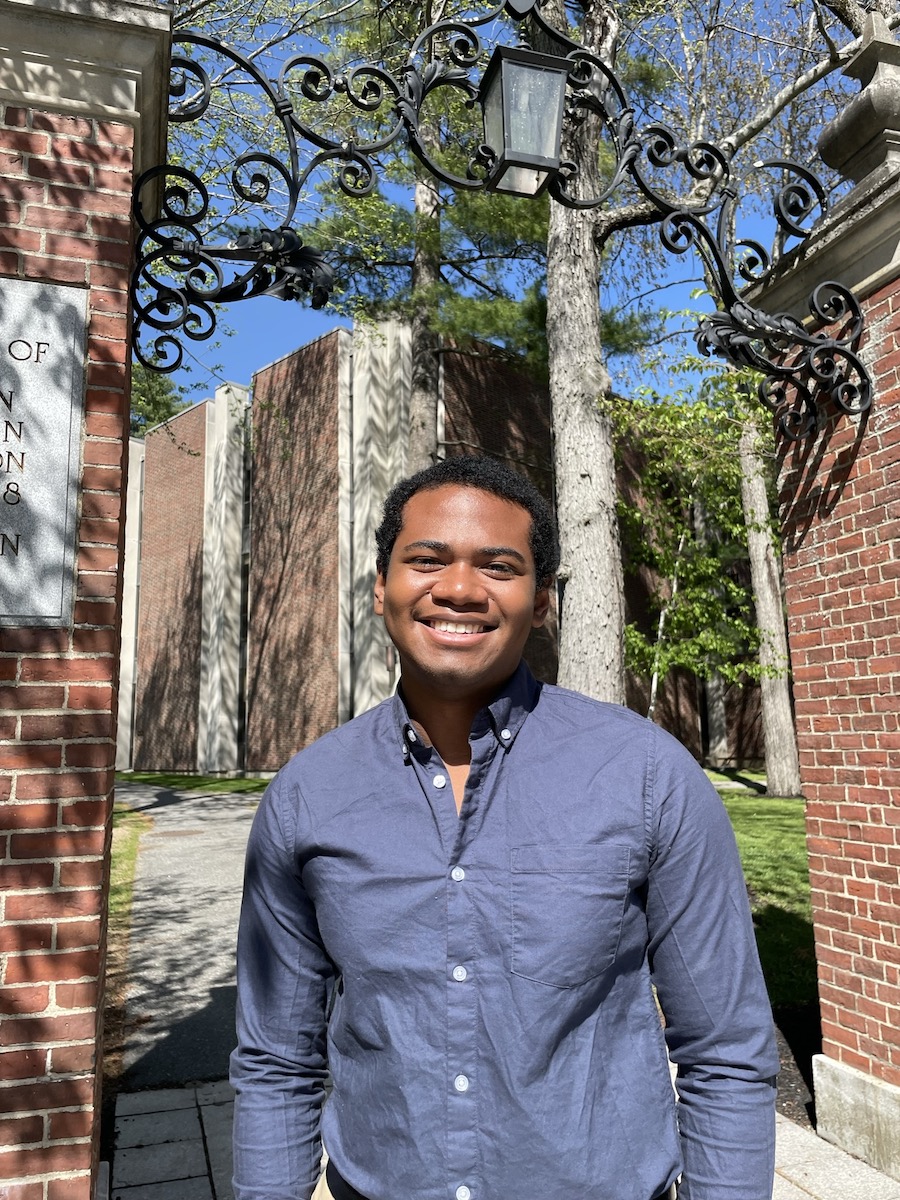Student Research

Thesis: "Identification of genes involved in Helicobacter pylori glycolipid and glycoprotein biosynthesis"
Advisor: Danielle Dube
Abstract: Helicobacter pylori is a gram-negative disease-causing bacterium that been linked to gastric carcinoma, and infection often leads to chronic gastritis and ulcers that can last for a lifetime if left untreated. Current efforts to cure H. pylori infection requires “triple therapy”. There is an urgent need for new therapeutics as increasing resistance to triple therapy has developed. H. pylori’s cell surface is decorated with highly ordered glycan structures containing unique monosaccharide building blocks that are critical for its virulence, therefore, bacterial glycans are attractive therapeutic targets. However, the genes responsible for the biosynthesis of glycosylated proteins and lipids in H. pylori are not fully known nor characterized. Recent work in our laboratory has shown that glycoprotein and glycolipid biosynthesis appear to occur via a shared lipid-carrier-mediated pathway that bifurcates. Therefore, in this study, we probed our working model of glycoprotein biosynthesis via construction of glycosylation mutants coupled to metabolic oligosaccharide engineering (MOE) to study glycan production. Our results identify additional genes involved in glycolipid and glycoprotein biosynthesis and allowed us to refine our working model of these overlapping pathways. Ultimately, this work has the potential to reveal targets for glycan-based antimicrobial interference strategies.
Most memorable biochemistry class: Biochemistry and Cell-biology with Bruce Kohorn
Since graduating: After graduating in May of 2022, I have been trying to enjoy the summer with friends and family and catch up on four years of sleep!
Thesis: "Genetic Analysis of Adhesion Protein ELMO3 in Arabidopsis thaliana"
Advisor: Bruce Kohorn
Abstract: The Extracellular Matrix (ECM) between plant cells is vital for structure, development,
and intercellular adhesion. A pectin rich layer in between cells, the middle lamella, is largely responsible for regulating the adhesive properties of adjacent plant cells. Homogalacturonan (HG) pectin, the most common, is synthesized in the Golgi and secreted into the ECM where it undergoes calcium crosslinking, increasing its adhesive properties. Mutations in proteins essential for HG synthesis can reveal a severe adhesion defective phenotype, where the hypocotyls of dark grown Arabidopsis exhibit cell sloughing, curling, and general disorganization. A family of five ELMO proteins are suspected to act as scaffolds for pectin biosynthesis enzymes. ELMO1 and ELMO4 mutants exhibit an adhesion deficient phenotype, and a double mutant provides evidence of redundancy in function between ELMO1 and ELMO2. ELMO1-GFP co-immunoprecipitated with enzymes required for HG synthesis indicating its role as a scaffold protein. Double mutants of the other ELMO homologues were created to determine if they exhibit functional redundancy, and ELMO1 and ELMO3 appear partially redundant. A gene deletion of ELMO3 was also created using the CRSPR/Cas9 system, resulting in two distinct elmo3 deletion alleles, which were phenotypically identical to the original elmo3-/- mutant. All adhesion defective phenotypes can be partially suppressed by altering the osmoticum and hence turgor that provides pressure on adhesive cells. Lastly, ELMO3-GFP was localized to the Golgi, the site of pectin biosynthesis, further supporting a common role of the ELMOs in pectin biosynthesis.
Most memorable biochemistry class: Biochemistry and Cell Biology
Since graduating: I am working in the Pinney Lab at UC San Francisco developing high throughput microfluidic assays to probe enzyme mechanics and function.

Thesis: "Impact of SR-Like RNA-Binding Protein (Slr1) Structure on Splicing in Candida albicans"
Advisor: Anne McBride
Abstract: The opportunistic fungal pathogen Candida albicans causes mild and severe diseases when not suppressed by the immune system, yet its mechanisms of gene expression remain poorly understood, particularly beyond the level of transcription. However, post-transcriptional regulation has recently been implicated in C. albicans drug resistance and fungal pathogenesis. Alternative splicing (AS) is one such post-transcriptional mechanism that greatly expands eukaryotic protein diversity and enables important regulatory functions. While associative relationships between AS and pathogenesis have been documented in C. albicans, the mechanisms through which introns are retained or removed remain unclear. The SR-like RNA binding protein 1 (Slr1) serves critical roles in C. albicans growth, filamentation, and virulence, and accumulating studies evince its role as a splicing factor. As an SR-like protein, Slr1 bears an RS domain whose phosphorylation likely influences Slr1 localization, expression levels, protein-protein interactions, and yet undetermined roles in gene expression. Given that phosphorylation of SR and SR-like proteins is required for most steps in pre-mRNA splicing, I tested the impact of blocking or mimicking the phosphorylation of Slr1 using mutational approaches. Intriguingly, structural modifications that mimic both the hyper- and hypophosphorylation of Slr1 are associated with reduced splicing of its own transcript, supporting a model in which Slr1 negatively autoregulates its protein levels through a phosphorylation-dependent mechanism involving the splicing of its pre-mRNA. This study demonstrates a novel mechanism of post-transcriptional regulation in C. albicans that enables future research into its gene expression, growth, and pathogenesis.
Most memorable biochemistry class: The RNA World with Anne McBride
Since graduating: I am currently working with Dr. Scott Martin in the Orthopaedic Sports Medicine Department at Massachusetts General Hospital. We are conducting basic science, translational, and clinical research aimed at advancing the care of musculoskeletal conditions affecting the hip, knee, and shoulder.

Thesis: "Characterizing variation in enhancer usage within and between natural populations of Drosophila by comparing chromatin conformation in non-coding DNA"
Advisor: Michael F. Palopoli
Abstract: The divergence of gene sequences underlies adaptive evolution by contributing to phenotypic diversity within and between species. While the importance of protein coding sequence polymorphisms in generating phenotypic diversity has been well documented, the role of non-coding polymorphisms in adaptive evolution remains unclear. Enhancers are cis- regulatory elements found within non-coding DNA that control gene expression by regulating transcription. To successfully regulate gene expression, enhancer sequences must be accessible to transcription factors (TFs). Therefore, identifying regions of open chromatin in non-coding regions of the genome can be used as a proxy to compare differential enhancer activity within and between species. Chromatin conformation was assessed across the genome for brain tissue of D. melanogaster natural isolates from Oregon, Colombia, Zimbabwe, and Ethiopia, as well as natural isolates of the closely related species D. mauritiana and D. simulans strains. Chromatin conformation was examined using the Assay for Transposase-Accessible Chromatin with high- throughput sequencing (ATAC-seq). The resulting sequencing data was analyzed with a custom ATAC-seq bioinformatics pipeline to analyze the quality of the data and determine how similar chromatin structures are between natural isolates. Furthermore, a portion of the X chromosome was scanned visually for differential peaks among the natural isolates. Analysis of the variation in genome coverage revealed clear divergence between Drosophila species. Visual peak analysis revealed examples of open chromatin regions in some flies but not others. These results support the hypothesis that regulatory variation underlies phenotypic diversity.
Most memorable biochemistry class: Biochemistry and Cell Biology
Since graduating: I am working as a Medical Scribe in New York City and coaching for Special Olympics.

Thesis: "Bacterial Coat of Armor: Probing how Glycan Biosynthesis in Helicobacter pylori Modulates Host Immune Recognition"
Advisor: Danielle Dube
Abstract: Helicobacter pylori is a gram negative, pathogenic, and opportunistic bacterium that is known to colonize more than 50% of all human gastrointestinal tracts. H. pylori is an alarming bacterium in the medical field due to its increasing antibiotic resistance rate. Cell surface bacterial glycans offer a unique potential target for new antibiotic therapeutics against H. pylori. These glycan structures and other molecules help create a sugar coat around H. pylori allowing the bacterium to evade the host’s immune system. The goal of this project is to assess the extent to which disruption of glycan biosynthesis in H. pylori modulates host immune recognition of the bacteria. Toward this end, the ability of human gastric adenocarcinoma cells (AGS) to recognize and respond to wild type (WT) H. pylori versus glycan biosynthesis mutants was compared by measuring AGS viability and expression of the cytokine CXCL-8 upon co-culturing with bacteria. In parallel, Thp-1 monocyte derived dendritic cell (DC) maturation rates were investigated after coculturing DCs with either WT H. pylori or glycan biosynthesis mutants. CXCL-8 expression was significantly diminished when AGS cells were cultured with the H. pylori glycosylation mutants compared to the WT. Additionally, DC maturation rates were significantly lower when DCs were exposed to the H. pylori glycosylation mutants compared to the WT. These preliminary results suggest that disruption of H. pylori glycan biosynthesis make the bacterium less immunogenic. Thus, the cell surface glycan structures on H. pylori appear important for immune recognition and response.
Most memorable biochemistry class: Advanced Cell and Molecular Biology with Bruce Kohorn
Since graduating: I am preparing to start a PhD program in biology at MIT in September where I hope to specialize in cancer immunology.

Thesis: "Metabolic Glycan Labeling in Bacteria Using Rare Azido L-Sugars"
Advisor: Danielle Dube
Abstract: The rapid rise of antibiotic resistance demonstrates the ineffectiveness of existing antibiotics. Bacterial glycans are compelling therapeutic targets as they link to pathogenesis and contain rare monosaccharides absent from human cells. However, the systematic study of bacterial glycans remains challenging due to the presence of exclusively bacterial sugars which hamper traditional glycan analyses. Thus, the development of chemical tools to study bacterial glycans is a crucial step toward understanding and altering these biomolecules. This project employs metabolic oligosaccharide engineering to accelerate the investigation of bacterial glycans bearing rare deoxy amino L-sugars. Briefly, azide-containing analogs of N-acetyl L-pneumosamine, N-acetyl-L-quinovosamine, N-acetyl L-rhamnosamine, and N-acetyl L-fucosamine were screened for metabolic incorporation into glycans in a range of pathogenic and symbiotic bacteria. L-sugar analogs were narrowly incorporated into select pathogenic species that reportedly express L-sugar presenting epitopes, namely Plesiomonas shigelloides and Vibrio vulnificus. Surprisingly, L-sugar analogs were also utilized by the pathogen Campylobacter jejuni despite having no previous reports of L-sugar-containing glycans in this species. In contrast, the gut symbiont Bacteroides fragilis did not exhibit any appreciable utilization of L-sugar analogs. Distinct strains of L-sugar bacteria displayed diverse azide-labeled glycan profiles. Finally, azido sugars selectively labeled glycoproteins in P. shigelloides and V. vulnificus. Further application of metabolic probes based on rare sugars will refine our knowledge of glycans in diverse bacteria and aid the design of novel antibiotics.
Most memorable biochemistry class: Chemical Biology
Since graduating: Currently I'm staying on campus for the summer to do research with Professor Danielle Dube. My research essentially extends on my honors thesis and I also train new students in the lab. My next plan in the fall is to pursue a PhD in chemistry at the Max Planck Institute of Colloids and Interfaces in Potsdam, Germany.

Thesis: "Characterization of the ELMO2 Protein that Mediates Cell Adhesion in Arabidopsis thaliana"
Advisor: Bruce Kohorn
Abstract: The binding of adjacent cells to one another, or cell adhesion, is critical for the growth and development of multicellular organisms. In plant cells, much evidence suggests that the amount and modification of pectin in the cell wall largely determines how well cell adhesion occurs. ELMO1 is a Golgi protein involved in pectin-mediated cellular adhesion, and mutations in ELMO1 lead to disrupted cell organization in Arabidopsis. ELMO1 is predicted to be a scaffold for pectin biosynthesis enzymes, and thus its absence leads to the adhesion-defective phenotype of elmo1-/- plants. There are four other ELMO homologues (ELMO2,3,4 and 5) which remain to be characterized as to their function and role in cell adhesion. This thesis focuses on the characterization of ELMO2, which has 79% amino acid similarity with ELMO1. A genetic analysis that evaluated elmo2 double mutants revealed that ELMO2 and ELMO1 have redundant functions. elmo1-/-/2-/- double mutants, but not elmo2-/- or elmo1-/- single mutants, have reduced tensile strengths. While elmo1-/- phenotypes are most pronounced in liquid media, they are partially rescued by growth on agar, suggesting a role of turgor in maintaining cell adhesion. Like ELMO1, ELMO2-GFP colocalizes with Golgi markers. The results suggest that like ELMO1, ELMO2 also functions as a scaffold for pectin biosynthesis enzymes in the Golgi.
Most memorable biochemistry class: The RNA World with Anne McBride
Since graduating: I am currently working at a biotechnology startup in San Diego, where I utilize next-generation sequencing (NGS) and flow cytometry to quantify the efficacy of novel cancer therapeutics.